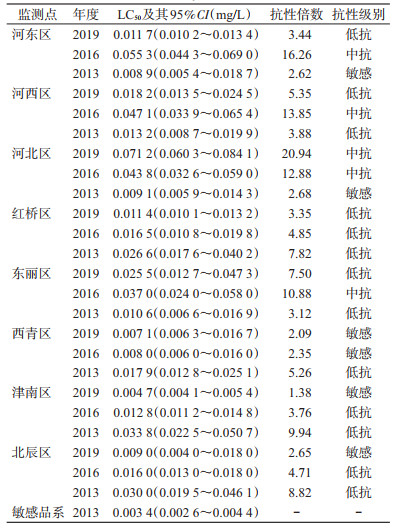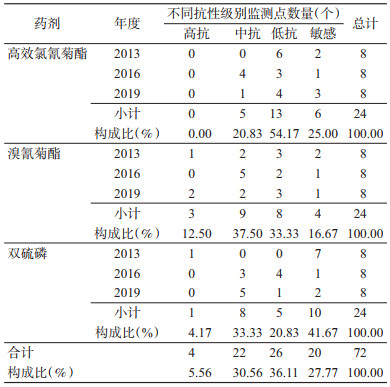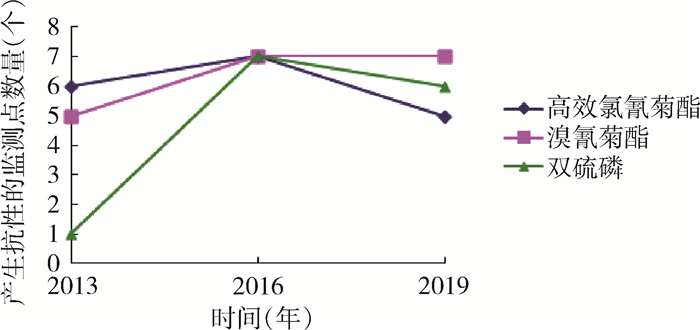扩展功能
文章信息
- 张咏梅, 王姝, 胡晓辉, 赵杨, 戈磊, 薄立超
- ZHANG Yong-mei, WANG Shu, HU Xiao-hui, ZHAO Yang, GE Lei, BO Li-chao
- 天津市2013-2019年淡色库蚊对常用杀虫剂的抗药性监测分析
- Surveillance and analysis of the resistance of Culex pipiens pallens to commonly used insecticides in Tianjin, China, 2013-2019
- 中国媒介生物学及控制杂志, 2020, 31(4): 438-441
- Chin J Vector Biol & Control, 2020, 31(4): 438-441
- 10.11853/j.issn.1003.8280.2020.04.012
-
文章历史
- 收稿日期: 2020-05-08
2 天津市北辰区疾病预防控制中心, 天津 300499;
3 天津市红桥区疾病预防控制中心, 天津 300130;
4 天津市东丽区疾病预防控制中心, 天津 300300;
5 天津市河西区疾病预防控制中心, 天津 300211;
6 天津市西青区疾病预防控制中心, 天津 300380
2 Beichen District Center for Disease Control and Prevention;
3 Hongqiao District Center for Disease Control and Prevention;
4 Dongli District Center for Disease Control and Prevention;
5 Hexi District Center for Disease Control and Prevention;
6 Xiqing District Center for Disease Control and Prevention
媒介生物中蚊类传播疾病最多也最严重.淡色库蚊(Culex pipiens pallens)是班氏丝虫病和流行性乙型脑炎等疾病的重要传播媒介.自20世纪50年代起我国就以化学防治作为蚊虫防治的主要手段[1].化学杀虫剂大量、连续地使用致使蚊虫抗药性迅速增强[2].淡色库蚊为天津市优势蚊种[3],自90年代至今天津市一直系统地开展淡色库蚊抗药性监测工作[4].为了解近年来天津市淡色库蚊的抗药性水平及其变化趋势,本文比较分析了2013、2016和2019年天津市淡色库蚊对常用杀虫剂的抗性变化,旨在揭示其抗性发展动态,为科学合理使用杀虫剂提供科学依据.
1 材料与方法 1.1 测试对象淡色库蚊野外种群,于天津市8个监测点的大型水体及小型积水处采集幼蚊,实验室饲养1代,选择3龄末4龄初的幼蚊为测试对象.淡色库蚊敏感品系来自天津市疾病预防控制中心(CDC)虫媒饲养室.
1.2 供试药剂91.16%高效氯氰菊酯、94.62%溴氰菊酯、95.10%双硫磷原药,由中国CDC传染病预防控制所提供.
1.3 测试方法采用幼虫浸渍法.将药液用丙酮稀释成5~7个浓度梯度,取1 ml相应药液加入到装有199 ml脱氯水的烧杯中,对照组加1 ml丙酮.每个烧杯中放入30只试虫,在温度(26±1)℃、相对湿度(60±10)%下处理24 h,观察并记录试虫24 h的死亡数[5],计算半数致死浓度(LC50).实验重复3次.试虫死亡标准:用尖头镊子轻轻触动幼蚊头部或尾部呼吸管,如其不能浮至水面或呈麻痹痉挛状态均判为死亡.
1.4 数据处理采用SPSS 24.0软件计算LC50值及95%可信区间(95%CI),并与敏感品系进行比较,计算抗性倍数.抗性级别判定标准:依据中国CDC印发的《全国重要病媒生物抗药性监测方案》(中疾控传防发〔2016〕):抗性倍数<3为敏感,3≤抗性倍数<10为低抗,10≤抗性倍数<40为中抗,抗性倍数≥40为高抗.用χ2检验分析抗性结果.
2 结 果 2.1 不同监测点淡色库蚊对高效氯氰菊酯的抗性不同监测点2013、2016和2019年淡色库蚊对高效氯氰菊酯的抗性不同.所有监测点的淡色库蚊均未产生高抗水平,但不同年份产生中抗水平的监测点有5个,抗性最高的为河北区,抗性倍数为20.94倍;其次为河东区(16.26倍)、河西区(13.85倍)和东丽区(10.88倍),其他地区抗性情况见表 1.

|
不同监测点不同年份淡色库蚊对溴氰菊酯的抗性不同,高、中、低抗性水平均有发生.处于高抗水平的有3个区,其中抗性最高的为河东区,抗性倍数高达69.78倍;其次为河北区(47.89倍)和河西区(41.67倍),其他地区抗性情况见表 2.

|
不同监测点不同年份淡色库蚊对双硫磷产生的抗性水平不同,高、中、低水平均有发生.高抗水平的地区仅为北辰区,抗性倍数高达57.14倍,见表 3.

|
淡色库蚊对高效氯氰菊酯的中抗地区占比为20.83%,低抗地区占54.17%,敏感地区占25.00%.对溴氰菊酯的高抗地区占比为12.50%,中抗地区占37.50%,低抗地区占33.33%,敏感地区占16.67%.对双硫磷的高抗地区占比为4.17%,中抗地区占33.33%,低抗地区占20.83%,敏感地区占41.67%.经统计学分析,3种杀虫剂抗性地区占比差异无统计学意义(χ2=3.880,P>0.05),见表 4.

|
2013-2016年淡色库蚊对3种杀虫剂的抗性水平整体呈现上升趋势,2016-2019年高效氯氰菊酯和双硫磷抗性地区数量有所下降,分别由2016年的7个下降至2019年的5和6个,而溴氰菊酯抗性地区数量未发生变化,见图 1.

|
| 图 1 2013-2019年天津市淡色库蚊对3种杀虫剂的抗性趋势 Figure 1 Resistance trends of Culex pipiens pallens to three insecticides in Tianjin, China, 2013-2019 |
| |
拟除虫菊酯类杀虫剂因其低毒、高效等被广泛应用于卫生害虫的防治,但由于大量不规范使用、盲目滥用致使多地蚊虫对其产生了抗药性[6-8].多年以来,天津市蚊虫防治一直使用拟除虫菊酯类杀虫剂,且高效氯氰菊酯和溴氰菊酯近年使用比例高达70%.尽管拟除虫菊酯类药剂主要用于成蚊防治,但大量药剂的使用增加了水体中药剂的浓度,间接对幼蚊进行了施用,且拟除虫菊酯类杀虫剂极易产生抗药性,因此,本文监测结果显示,淡色库蚊对高效氯氰菊酯和溴氰菊酯均存在抗性,抗性地区占比分别达75.00%和83.33%.
双硫磷为有机磷类杀虫剂,其低毒、高效,是世界卫生组织推荐的唯一可用于饮用水的灭幼剂;目前,我国多数地区的淡色库蚊幼蚊对双硫磷仍处于敏感至中低抗性阶段[9].与拟除虫菊酯类杀虫剂相比,双硫磷的使用范围较窄,主要用于不宜清除的积水中,尤其是雨水井、集水井以及各种不易清除的污水.尽管天津市在创建卫生城市过程中,使用了一定量的双硫磷,但由于其抗性发展缓慢,监测结果显示,淡色库蚊对双硫磷仅存在中、低抗性.另外,林业、园林等防治中有机磷类杀虫剂的广泛使用不仅会导致外环境水体污染,还间接导致了淡色库蚊幼蚊对双硫磷抗性的产生.
监测结果显示,淡色库蚊对3种杀虫剂的抗性水平整体呈现先上升后下降趋势,2013-2016年抗性水平上升的主要原因可能与天津市为创建卫生城市大量使用杀虫剂有关;随后几年加强了环境治理,蚊虫孳生地逐渐减少,杀虫剂的使用量也随之下降,因而2016-2019年蚊虫抗性有所下降.
蚊虫抗药性的产生给防制工作带来了困难.从监测结果看,天津市淡色库蚊抗性水平虽然呈下降趋势,但存在高抗(5.56%)及中抗(30.56%)水平的地区比例仍然较高,因此抗药性问题不容忽视.建议今后天津市在蚊虫抗性治理时应根据抗药性监测结果,科学合理使用杀虫剂,同时注意杀虫剂的混用与轮用,延缓抗性产生.
| [1] |
王以燕, 姜志宽. 我国公共卫生用农药的发展及应用概况[J]. 中国媒介生物学及控制杂志, 2016, 27(5): 421-425. Wang YY, Jiang ZK. Development and application of public health pesticides in China, 2013-2016[J]. Chin J Vector Biol Control, 2016, 27(5): 421-425. DOI:10.11853/j.issn.1003.8280.2016.05.001 |
| [2] |
Liu NN. Insecticide resistance in mosquitoes:impact, mechanisms, and research directions[J]. Annu Rev Entomol, 2015, 60(1): 537-559. DOI:10.1146/annurev-ento-010814-020828 |
| [3] |
侯海光, 秦娜. 天津市2011-2015年蚊虫密度监测结果分析[J]. 中国媒介生物学及控制杂志, 2016, 27(6): 563-565. Hou HG, Qin N. Analysis on the mosquito surveillance results during 2011-2015, Tianjin[J]. Chin J Vector Biol Control, 2016, 27(6): 563-565. DOI:10.11853/j.issn.1003.8280.2016.06.009 |
| [4] |
白淑萍, 范俊兰, 张咏梅, 等. 3种杀虫剂杀灭蚊幼效果观察[J]. 医学动物防制, 1995, 11(4): 385-386. Bai SP, Fan JL, Zhang YM, et al. Observation on the efficacy of three insecticides in killing mosquito larvae[J]. J Med Pest Control, 1995, 11(4): 385-386. |
| [5] |
中华人民共和国卫生部. GB/T 26347-2010蚊虫抗药性检测方法生物测定法[S].北京: 中国标准出版社, 2011. Ministry of Health of the People's Republic of China. GB/T 26347-2010 Test methods of mosquito resistance to insecticides-Bioassay methods[S]. Beijing: Standards Press of China, 2011. |
| [6] |
宋晓, 程鹏, 王海防, 等. 鲁西南地区淡色库蚊抗药性评价[J]. 中国血吸虫病防治杂志, 2020, 32(1): 69-72. Song X, Cheng P, Wang HF, et al. Study on insecticide resistance of Culex pipiens pallens in southwest region of Shandong province[J]. Chin J Schisto Control, 2020, 32(1): 69-72. DOI:10.16250/j.32.1374.2018261 |
| [7] |
吴旭, 周博, 胡晓芳. 沈阳市淡色库蚊密度监测及其对杀虫剂的抗性调查[J]. 中华卫生杀虫药械, 2020, 26(2): 125-127. Wu X, Zhou B, Hu XF. Investigation on the density and insecticide resistance of Culex pipiens pallens in Shenyang[J]. Chin J Hyg Insect Equip, 2020, 26(2): 125-127. DOI:10.19821/j.1671-2781.2020.02.009 |
| [8] |
李洁, 毛树存, 陈正利, 等. 2018年许昌市淡色库蚊对5种常用杀虫剂抗药性调查[J]. 河南预防医学杂志, 2020, 31(3): 200-202. Li J, Mao SC, Chen ZL, et al. Investigation on resistance of Culex pipiens pallens to 5 commonly used insecticides in Xuchang of Henan in 2018[J]. Henan J Prev Med, 2020, 31(3): 200-202. DOI:10.13515/j.cnki.hnjpm.1006-8414.2020.03.011 |
| [9] |
孟凤霞, 靳建超, 陈云, 等. 我国淡色库蚊/致倦库蚊对常用化学杀虫剂的抗药性[J]. 中国媒介生物学及控制杂志, 2011, 22(6): 517-520, 528. Meng FX, Jin JC, Chen Y, et al. Resistance of Culex pipiens pallens/Cx. pipiens quinquefasciatus to commonly used insecticides in China[J]. Chin J Vector Biol Control, 2011, 22(6): 517-520, 528. |
 2020, Vol. 31
2020, Vol. 31

